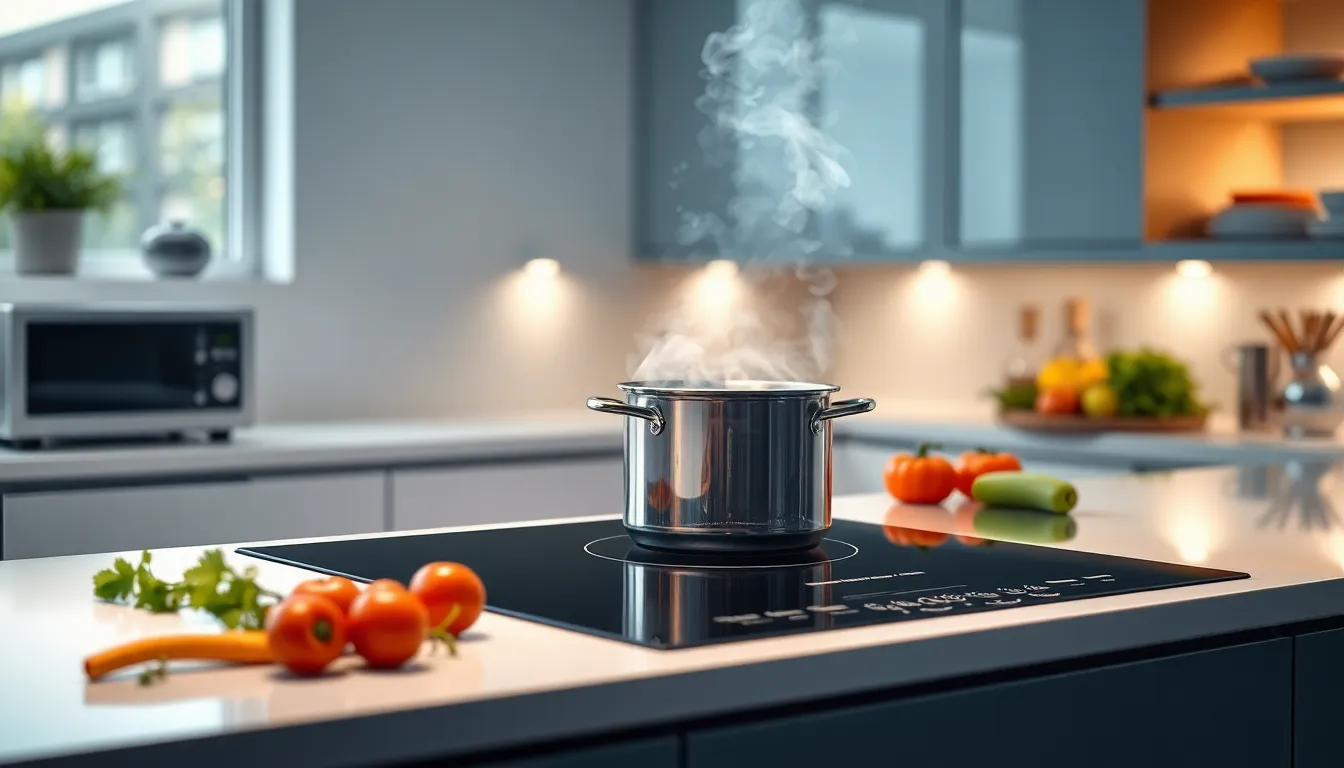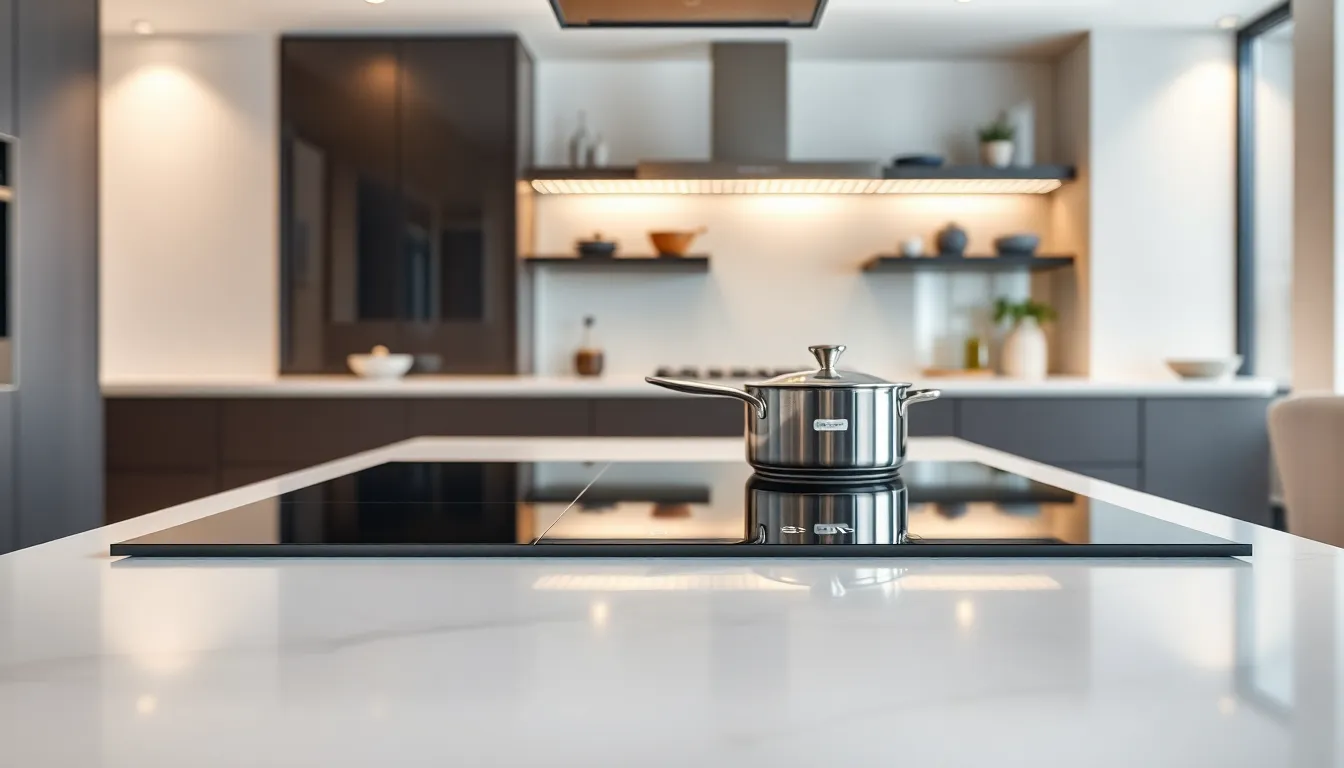Induction cooktops are like the superheroes of the kitchen, swooping in to save the day with their speed and efficiency. Imagine cooking your favorite meal faster than you can say “dinner’s ready!” These sleek appliances use electromagnetic energy to heat pots and pans directly, leaving the cooktop cool enough to host a dance party—no burns or singed eyebrows here.
Table of Contents
ToggleWhat Are Induction Cooktops?
Induction cooktops enhance kitchen efficiency through their quick cooking capabilities via electromagnetic energy. These appliances also prioritize safety, as the surface remains cool, reducing the risk of burns.
How Induction Cooking Works
Induction cooking operates using electromagnetic fields to generate heat directly in cookware. Magnetic coils beneath the cooktop create a magnetic field when activated, which then heats compatible pots and pans. This method provides instant heat adjustments, enabling precise temperature control. Cooking surfaces stay cooler, minimizing heat loss and enhancing energy efficiency. As a result, induction cooking prepares food swiftly and evenly.
Key Components of Induction Cooktops
Induction cooktops contain several essential components that contribute to their functionality. The cooktop surface typically consists of glass-ceramic material, designed to withstand high temperatures and facilitate easy cleaning. Magnetic coils provide the necessary energy for induction heating. An induction sensor detects the presence of compatible cookware, ensuring efficient energy use. Additionally, control panels allow users to adjust settings for precise cooking. These components work together to create a seamless cooking experience.
Advantages of Induction Cooktops

Induction cooktops offer numerous advantages that enhance the cooking experience. Their unique cooking mechanism leads to various benefits, such as energy efficiency, speed, and safety.
Energy Efficiency
Energy efficiency stands out as a hallmark of induction cooktops. They transfer approximately 90% of the energy produced directly to the cookware. In contrast, traditional gas and electric ranges only convert about 40% to 65% of their energy. Reduced heat loss leads to lower energy bills. Minimal heat escaping into the kitchen keeps the environment comfortable. Faster heating enables cooks to prepare meals while conserving energy.
Speed of Cooking
Speed of cooking also proves significant with induction cooktops. Heating occurs almost instantly due to the direct transfer of energy. Boiling water on an induction cooktop can take as little as 1 minute and 30 seconds. Adjusting temperatures during cooking happens rapidly, allowing for greater control. This quick response time results in shorter meal preparation times, making it ideal for busy households. Cooks appreciate the efficiency and speed, especially when multitasking in the kitchen.
Safety Features
Safety features enhance the appeal of induction cooktops. The cooking surface remains cool to the touch, reducing the risk of burns during meal preparation. Specific sensors detect the presence of compatible cookware, ensuring that heat only generates when appropriate pots and pans are used. Automatic shut-off capabilities activate if the cookware is removed, promoting safety in the kitchen. These features make induction cooking a preferred option for families and novice cooks alike.
Disadvantages of Induction Cooktops
Despite their advantages, induction cooktops present some drawbacks that potential buyers should consider.
Cost Considerations
Cost remains a primary concern. Induction cooktops often come with a higher price tag compared to traditional gas or electric ranges. Prices can range from $200 to over $3,000, depending on the brand and features. Factors like installation fees or necessary electrical upgrades may also add to the overall cost. While long-term energy savings can offset some of these expenses, the initial financial investment may deter some households from choosing this option.
Compatibility with Cookware
Compatibility with cookware presents another challenge. Not all pots and pans work with induction cooktops; only those made of ferrous materials are suitable. Common materials, such as glass and aluminum, won’t generate heat on these surfaces. This limitation necessitates investment in new cookware, potentially increasing overall costs. Cookware must also have a flat bottom for optimal performance, which may restrict choices for specific cooking styles.
Learning Curve
Learning curve issues may arise as well. Users accustomed to traditional cooking methods may need time to adjust to the quick heat changes of induction cooking. Instant heat adjustments might come as a surprise, requiring some practice to master. Adjusting to setting temperature levels precisely also entails familiarity with controls and settings on different models. Challenges like these can frustrate novice cooks before they acquire confidence in using induction cooktops.
Popular Brands of Induction Cooktops
Several brands dominate the induction cooktop market, offering a range of options for various cooking needs. Each brand showcases unique features and technologies designed to enhance the cooking experience.
Brand A Overview
Bosch stands out as a top choice for induction cooktops, known for its sleek designs and reliable performance. With models ranging from $1,000 to $2,500, Bosch offers features like touch controls and precise temperature settings. This brand’s cooktops often include a FlexInduction zone, allowing flexibility in pot placement. Users appreciate the easy installation and quality materials used in construction. Bosch’s reputation for high energy efficiency adds to its appeal among eco-conscious consumers.
Brand B Overview
Samsung brings innovation to induction cooking with advanced technology and user-friendly designs. Prices for Samsung cooktops typically fall between $800 and $2,000. One popular feature is the Virtual Flame Technology, which simulates a gas flame appearance for intuitive cooking. Many models offer Wi-Fi connectivity, enabling remote monitoring and control through a smartphone app. Samsung’s commitment to safety includes automatic shut-off capabilities, making it a smart option for families.
Brand C Overview
KitchenAid is well-known for its robust and stylish induction cooktops, combining aesthetics with functionality. Priced from $1,000 to $3,000, KitchenAid models often feature high-performance induction heating for quick cooking. Users enjoy versatile configurations, including a combination of standard and gourmet appliances. Additionally, the intuitive knobs and sliders allow for precise heat adjustments. KitchenAid’s offerings are appreciated for their durability, appealing to both home chefs and professional kitchens.
Induction cooktops represent a significant advancement in kitchen technology. Their efficiency safety and speed make them an attractive choice for modern cooking. While the initial investment may be higher and compatibility with cookware can pose challenges, the benefits often outweigh these drawbacks. Families and busy cooks alike can appreciate the quick meal preparation and energy savings that induction cooking offers. As brands continue to innovate with features and designs the appeal of induction cooktops will likely grow, making them a staple in more households. Embracing this cooking method could transform the culinary experience for many.







